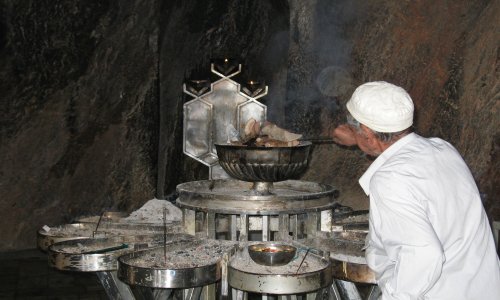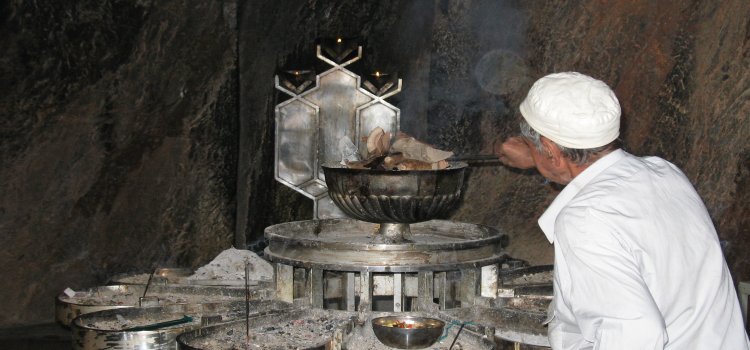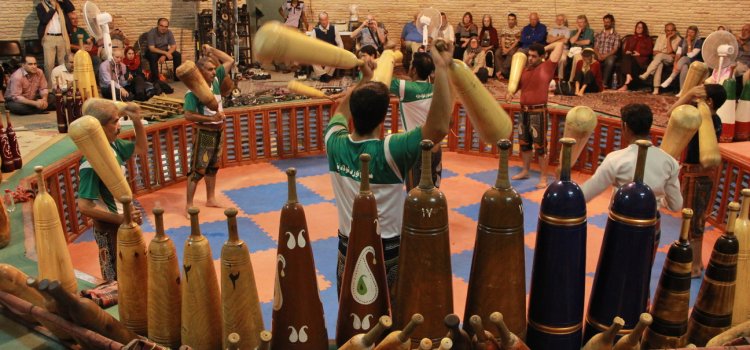The cosmogonic myth of the Zoroastrians
The material world as an entity composed of seven creations of the God Ahura Mazda, each under the protection of a “beneficent immortal” Amahraspands, a species of archangel.
The cosmogonic myth of the Zoroastrians
The material world as an entity composed of seven creations of the God Ahura Mazda, each under the protection of a “beneficent immortal” Amahraspands, a species of archangel.
🥚a stone sky designed like an eggshell surrounding the rest; then water filling the bottom of the shell.
🌎the earth floating on primitive waters like a flat disc (the mountain anchoring the earth) in the center of the earth, a single plant, 🐂a unique bull and the first man “Gayomard”, immortal life protected by Ahura Mazda itself, well, fire, visible in the sun and other celestial bodies.
everything is going well until Ahreman, the evil Spirit then attacks the creations of hormezd …

Zourkhaneh, traditional sport in iran
Zurkhane is an Iranian traditional sport which philosophy consists in mental and physical improvement.
The athletes not only build their body muscles, but also improve their morality and behaviour by performing ancestral movements.
Zourkhaneh, traditional sport in iran
Zourkhaneh is an Iranian traditional sport which philosophy consists in mental and physical improvement.
The athletes not only build their body muscles, but also improve their morality and behavior by performing ancestral movements.
The gentlemen gather in a small arena that is built slightly below street level to provide constant temperature. In the middle of the arena there is a round or octogonal sunken area named “Gowd”. The exercise starts with a warm up following the rythm of the Morshed, the master of ceremony who plays tombak and manage the training, singing traditional songs (mostly from Shanameh of Ferdowsi that is the epic of Iranian heroes and athletics). Then they start to play with some special instruments like wooden maces, shields, bows, which have been inspired from the antique weapons.
Some movements remind us the whirling Sufi dance.
The tradition dictates that the older athletes and If one is descendant of the Prophet of Islam (Seyed), have to be more respected, whatever their skills, experience or body condition. the ovation would turn to a salavat, the formula of praise and salutation to prophet Mohammad and his family.
It is said that the origin of this art goes back to the time that Iran was under Mongol domination, the persian warriors secretly trained to organize the insurrection against the invaders.
The entrance of the ceremonies are absolutely free for the spectators, but they can give money, collected in a vase for charities.

Zoroastrianism, Iranians ancient religion
“Zoroaster” is the name generally known in the West for the prophet of ancient Iran,
whose transformation of his inherited religion inaugurated a movement that eventually became the dominant religion in Iran up until the triumph of Islam.
Zoroastrianism, Iranians ancient religion
Zoroastrianism is Iranians ancient religion, Zoroaster is the name generally known in the West for the prophet of ancient Iran, whose transformation of his inherited religion inaugurated a movement that eventually became the dominant religion in Iran up until the triumph of Islam. Controversy over Zaraθuštra’s date has been an embarrassment of long-standing to Zoroastrian studies. If anything approaching a consensus exists, it is that he lived ca. 1000 BC.
There is really nothing in the Gathas (oldest part of Avesta , zoroastriens holy book) which might give a clue where Zoroaster lived or the areas in which he was active.
Even though there are later traditions which place him in Azerbaijan and Media, it is more reasonable to locate Zoroaster somewhere in eastern Iran along with the rest of the Avesta. The Gathas offer scant information about the life of the prophet. Apparently, Zaraθuštra’s position within his own society became so precarious that he was forced to flee. Ethics plays a predominant role in Zaraθuštra’s thought. Part and parcel of Zaraθuštra’s ethical vision was the belief in rewards and punishments in the afterlife. Although it is impossible to know whether or not it was his innovation, Zaraθuštra was the first in recorded human history to articulate a clear theology of heaven for the righteous and a hell for the wicked.

Fire Temple
Yazd Zoroastrian fire temple is a holy monument in which the 1500-year old fire is maintained.
The fire is one the 4 holly elements for the Zoroastrian and also the most important one because not only it’s not been contaminated…
Yazd Zoroastrian Fire Temple
The fire temple of Yazd, also known as Ᾱtash-kadeh Yazd, is one of the holiest places in Iran where followers of the ancient religion of Persia, Zoroastrianism, gather to perform their religious rituals. Although the fire temple itself was built in the 20th century, it holds in its heart one of the most sacred, highly respected types of fire in Zoroastrianism, Ᾱtash Bahram (Raham) or the victorious fire. Zoroastrians, and also historians, believe that the holy Ᾱtash Bahram in the fire temple of Yazd dates back to 470 AD, burning and giving light to the world for around 1500 years.
However, apart from its religious prominence, the Zoroastrian fire temple of Yazd is one of the major tourist attractions in this city. Each year, a large number of eager tourists come to the beautiful Ᾱtash-kadeh of Yazd to visit this sacred place and learn more about Zoroastianism, the first monotheistic religion of the world.
So, if you are going to visit this unique fire temple in the city of Yazd, we strongly suggest that you read the following article to learn whatever you need know before attending this holy place.
A Short History of the Fire Temple of Yazd
During the rule of Achaemenids (550-330 BCE) and Sasanians (224-642CE), Zoroastrianism was the estate religion of Iran. However, after the Arab conquest of Persia in the 7th century AC, Iranians gradually gave up their old religion and converted to Islam. In the 10th century, a large group of Iranian Zoroastrians fled to India and became known as Parsis. Nevertheless, a minority of Zoroastrians remained in Iran, keeping their religion alive in its homeland.
As a minority, Zoroastrians suffered from widespread persecution for long, long years. However, when Reza Shah Pahlavi came to throne, he gave his assent for the construction of an Atash-Kadeh (Fire Temple) in Yazd. Therefore, a group of Iranian Zoroastrians came together to build the fire temple of Yazd city.
As the story goes, Amānat brothers, who were going to keep alive the memory of their father, Ardeshir Mehraban Rostam, dedicated a piece of land as large as 6,881 square meters for the construction of Yazd Fire Temple. Nevertheless, they were short of capital and had to raise funds to build the holy fire temple.
In his memoire, Jamshid Amānat tells the story of his hardships in traveling to India, four times by steam ships and one time by camels and also on foot, to persuade the Indian Parsi Association to pay for the construction of Yazd Fire Temple. At last, Hama Baee agreed to provide the necessary financial resources for the construction of the fire temple.
So, Parsi engineers designed the fire temple and Arbāb Jamshid Amānat supervised its construction and, in this way, Bahram Fire Temple finally came into being in the year 1934.
A Word on the Holy Fire Burning in the Fire Temple of Yazd
Well, let us tell you some interesting facts about the different types of fire lightening the world of Zoroastrianism. Actually, there were three types of fire used in the Zoroastrian world of Persia:
- Court fire burning in houses,
- Aderan (Azaran, Darmehr) fire which was superior to the court fire, lightening larger areas such as cities,
- Fire and Raham (Bahram), or the victorious fire, the most general and prestigious fire types simmering in Zoroastrian fire temples. Currently, you can visit only two samples of this type of in Iran, one in Yazd and the other in Kerman. As Zoroastrians believe, the Bahram Fire itself includes 16 different types of fire and thunderbolt lightening. Each one of these 16 different types has a name which are: Dyer, King or Governor, Potter, Brick, Dervish, Goldsmith, Mint, Armorer, Baker, Distiller, the Army Commander, Shepherd, Religious Leader, Sky Lightning, and, finally, Dead Burner.
As the story goes, the Bahram fire burning in Atashkade Yazd was first kept in one of the greatest Sassanian fire temples, the well-known Pars Kariyan (Azar Farnbagh) fire temple. This fire temple was located in Larestan, a city about 350 km to the South-east of Shiraz. Then, it was taken to Aqda, a city in Yazd province. The victorious fire burnt in Aqda for about 700 years. After that, it was kept alight for 300 years in Ardakan, another city in Yazd province. Finally, the victorious fire landed in the city of Yazd, and with the construction of the Fire Temple of Yazd, it has rested there up to now.
The Architecture and Decorations of the Yazd Fire Temple
The Main Yard: A Symbolic Space of Zoroastrian Beliefs
As you pass through the gates of Yazd Fire Temple, you will enter a large yard, surrounded by ever green cypresses and planes. In the middle of the yard, there is a circular pool filled with water, reflecting back the whole monument.
Behind the pool, there is located the main building of the fire temple of Yazd. Built on a 21-meter-high platform, you should ascend eight steps to enter a small porch which leads into the holly building. Four high-rising columns stand upright in front of the porch, decorating the façade of the main building.
The stone capitals of the columns and the flowers embellishing the walls of the building are delicate works of art by Isfahani stonemasons. These works of art were carved by artists in Isfahan and then were brought to Yazd.
Above the entrance, there is the figure of Faravahar, made by expert Yazdi artists.
The Main Hall
In the porch, there are two wooden doors. Take the one on your right to enter the main hall. As you step into the main hall, you will find a space covered with white marbles, decorated mostly with quotes from Avesta and portraits of the prophet of ancient Persia, Zoroaster.
In the middle of the main hall, you will encounter a glass window through which you will be able to see the holy Atash Bahram (Bahram Fire).
The scared Atash Bahram is kept burning in a bronze container, located on a platform a few meters above the ground level. The bronze container is located itself in a large room, surrounded by other smaller rooms which are used for praying and other religious rutuals.
A person, called “Hirbod”, is responsible for keeping the fire alive. He preserves the fire by adding a piece of dry wood, usually almond and apricot which take longer to be burnt out, several times a day. The remaining ash is of no importance, so it is emptied out of the container whenever necessary.
Visitors can see the fire only through the glass as no human breath should contaminate the pure fire. It is interesting for all tourists that this fire has been burning for this long. They can even smell some of the fire while looking through the glass.
Varjavand Hall
It was in 1939 that Mr. Jamshid Amanat built a hall and a water reservoir in the Yazd Fire Temple complex in memory of his wife. The hall building was destroyed and unusable in 2002 due to old age. Engineer Parviz Varjavand renovated this hall and completed the renovation in 2008, keeping its old style. He did this in memory of his parents, Dr. Fereydoun Varjavand and Dolat Rostami, and the name of Varjavand remained on the hall.
Now, Varjavand Hall has become an exhibition where you can learn more about Zoroastrians, traditions, and religious customs. There are different mannequins, photos and there. In one corner there are a bride and a groom and you read about them, and in another corner, you get information about the Nowruz and the ceremony of the followers of this religion. You can learn about the Zoroastrian prayer, the religious customs, and the ritual of dressing in the same hall.
Water Reservoir of Yazd Fire Temple
Jamshid Amanat was the one who built a water reservoir in the Zoroastrian fire temple. Today, you can visit this reservoir be on the ground floor of Varjavand Hall. On the ground floor, before entering the reservoir, you will encounter an exhibition space where you can see pictures taken by various photographers on subjects related to Zoroastrians. From Nowruz to prayers and religious customs, you can see and learn about them in these photos.
In a corner of the exhibition hall, you have to go down the stairs to enter the water reservoir. The end of the staircase was blocked in the past. And people used a faucet installed at the bottom of the water tank to get the water they needed. Now this faucet and the wall are not there anymore, so tourists can enter the water reservoir room and pay a visit. It’s the water of the qanat that flows through the upper valve of the reservoir so that people can access it.


